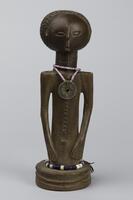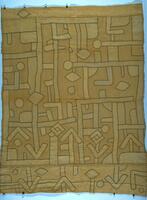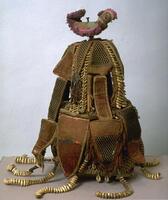A very quickly assembled group of objects that could be interesting, not necessarily for the status of the artist. Of these I think that a couple of the gold weights--particularly those that can be easily connected to known proverbs-- would be a nice tie-in back to Ray's lecture and to the exam--as I included a Sankofa in the test. I basically snapped up a few things in different media and from different historical moments. Laura will know which objects (if any) of these have noteworthy backstories. That would be another criterion for inclusion.
This is random selection is the result of a very quick skim through the rich holdings of the UMMA, so feel free to ignore or substitute other objects. In terms of getting students to really engage with them, less is more, as always...
3 Items in this Learning Collection
Copyright
House of the Head
1991/2.92
Title
House of the Head
Artist(s)
Yoruba
Artist Nationality
Yoruba (culture or style)
Object Creation Date
1880-1940
Medium & Support
leather, carved wood, cloth, metal and cowrie shells
Dimensions
17 1/8 in x 11 7/16 in x 11 7/16 in (43.5 cm x 29 cm x 29 cm)
Credit Line
Gift of the Honorable Jack Faxon in memory of Pauline Faxon
Label copy
Yoruba perceive the head as a threshold to divinity, symbolized by the bird that surmounts this example. Such shrines hold a person's spirtual essence and individuality that reside in the "inner head." Yoruba believe that the self has both exterior, public qualities, as well as interior ones, such as composure, and patience. The following prayer for everyday affairs expresses the principle that the inner head should rule the outer: "May my inner head not spoil my outer one." A house-of-the-head shrine is carefully guarded as the source of personal strength and courage.
Subject matter
An ile ori, meaning "house of the head", highlights the importance that Yoruba peoples placed on the head or ori. A person's inner head (ori inu) held their life force (ase) and their character (iwa); in the division of an inner and outer self, the inner self took precedence. In past practice, an altar or shrine was created to represent one's inner head, a cowrie-covered conical object called an ibori. This was kept in the ile ori, which would receive gifts and prayers just as an orisa (a Yoruba god) would. The cowrie shells are a symbol of the riches a "good head" – that is, having good character – can bring, as Yoruba peoples previously used cowrie shells as currency. The triangular flaps are 2-D representations of cones, one of the oldest symbols of ase, while the bird perched at the top is symbolic of the mind as a place of divinity.
References Cited:
Drewal, Henry John and John Mason. 1998. Beads Body and Soul: Art and Light in the Yoruba Universe. Los Angeles: UCLA Fowler Museum of Cultural History.
Drewal, Henry John, John Pemberton and Rowland O. Abiodun. 1989. Yoruba: Nine Centuries of African Art and Thought. New York: Center for African Art.
Lawal, Babatunde. 2012. Visions of Africa: Yoruba. Milan: 5 Continents Editions.
Thompson, Robert Farris. 1983. Flash of the Spirit: African and Afro-American Art and Philosophy. New York: Random House.
Physical Description
A large base cylinder covered with cowrie shells, triangular flaps made of red and spotted cloth, and leather; some of the flaps have fringes around the edge. Single strands of cowrie shells hang from the base. A smaller, open cylinder sits on top, made of four intersecting bands of cowrie shells. Between the bands are leather and cloth flaps in the shape of triangles attached to rectangles. Across the cowrie shell bands hang four more triangular flaps, some with fringes. The object is topped by a figure of a bird, attached by a metal nail.
Primary Object Classification
Sculpture
Primary Object Type
altarpiece
Collection Area
African
Rights
If you are interested in using an image for a publication, please visit http://umma.umich.edu/request-image for more information and to fill out the online Image Rights and Reproductions Request Form. Keywords
Birds
ceremonial objects
communication (function)
head
knowledge
personal shrines
shells
souls



